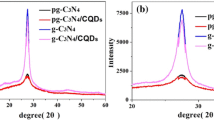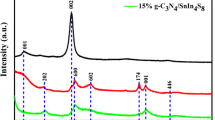Abstract
A simple colloidal crystal template method was used to prepare Sn/TiO2/graphite carbon microsphere composites (xSn/TiO2/GCM, x = 2.0, 1.0, 0.2, 0.5) with porous layers. Then, the composites were represented using X-ray diffraction, energy dispersive spectrometry, scanning electron microscopy, transmission electron microscopy, and nitrogen physical adsorption/desorption. Meanwhile, the photocatalytic activities in CO2 reduction were studied under simulation of visible light exposure. It was confirmed that the Sn/TiO2/GCM composites had layered porosity, graphitized carbon matrix, and high metal compound content, and their morphology was greatly affected by the acetone amount. The outputs of CO and CH4 coming into the photocatalytic CO2 reduction reaction of Sn/TiO2/GCM were 619.46 and 14.46 μmol g−1, respectively. Among the two products, the highest production rate observed in 0.5Sn/TiO2/GCM. Because of these factors, the layered porous Sn/TiO2/GCM composites have good photocatalytic performance under simulated visible light irradiation and have unique composition and structure characteristics, which give broad application prospects in electrode materials, catalysts, and adsorbents.

Graphical abstract








Similar content being viewed by others
References
Cai Q, Liu CL, Yin CC, Huang W, Cui LF, Shi HC, Fang XY, Zhang L, Kang SF, Wang YG (2017) Biotemplating synthesis of graphitic carbon coated TiO2 and its application as efficient visible-light-driven photocatalyst for Cr6+ remove. ACS Sustain Chem Eng 5:3938–3944
Crake A, Christoforidis KC, Kafizas A, Zafeiratos S, Petit C (2017) CO2 capture and photocatalytic reduction using bifunctional TiO2/MOF nanocomposites under UV–vis irradiation. Appl Catal B-Environ 210:131–140
Deng LD, Arakawa T, Ohkubo T, Miura H, Shishido T, Hosokawa S, Teramura K, Tanaka T (2017) Highly active and stable Pt−Sn/SBA-15 catalyst prepared by direct reduction for ethylbenzene dehydrogenation effects of Sn addition. Ind Eng Chem Res 56:7160–7172
Gong SQ, Jiang ZJ, Shi PH, Fan JC, Xu QJ, Min YL (2018) Noble-metal-free heterostructure for efficient hydrogen evolution in visible region: molybdenum nitride/ultrathin graphitic carbon nitride. Appl Catal B-Environ 238:318–327
Hengne AM, Samal AK, Enakonda LR, Harb M, Gevers LE, Anjum DH, Hedhili MN, Saih Y, Huang KW, Basset JM (2018) Ni–Sn-supported ZrO2 catalysts modified by indium for selective CO2 hydrogenation to methanol. ACS Omega 3:3688–3701
Hsieh PY, Chiu YH, Lai TH, Fang MJ, Wang YT, Hsu YJ (2019) TiO2 nanowire-supported sulfide hybrid photocatalysts for durable solar hydrogen production. ACS Appl Mater Inter 11:3006–3015
Huang HW, Lin JJ, Fan LZ, Wang XX, Fu XZ, Long JL (2015) Heteroatomic Ni Sn clusters-grafted anatase TiO2 photocatalysts structure electron delocalization and synergy for solar hydrogen production. J Phys Chem C 119:10478–10492
Ismail AM, Samu GF, Balog A, Csapó E, Janáky C (2019) Composition-dependent electrocatalytic behavior of Au–Sn bimetallic nanoparticles in carbon dioxide reduction. ACS Appl Mater Inter 4:48–53
Izumi Y (2013) Recent advances in the photocatalytic conversion of carbon dioxide to fuels with water and/or hydrogen using solar energy and beyond. Coord Chem Rev 257:171–186
Kang SF, Li S, Pu T, Fang X, Yin C, Dong M, Cui L (2018) Mesoporous black TiO2 array employing sputtered au cocatalyst exhibiting efficient charge separation and high H2 evolution activity. Inter J Hydrogen Energ 43:22265–22272
Li K, Peng B, Peng TY (2016) Recent advances in heterogeneous photocatalytic CO2 conversion to solar fuels. ACS Catal 6:7485–7527
Li GJ, Huang JQ, Chen J, Deng ZH, Huang QF (2019a) Highly active photocatalyst of Cu2O/TiO2 octahedron for hydrogen generation. ACS Omega 4:3392–3397
Li X, Yu J, Jaroniec M, Chen X (2019b) Cocatalysts for selective photoreduction of CO2 into solar fuels. Chem Rev 119:3962–4179
Low JX, Zhang LY, Zhu BC, Liu ZY, Yu JG (2018) TiO2 photonic crystals with localized surface photothermal effect and enhanced photocatalytic CO2 reduction activity. ACS Sustain Chem Eng 6:15653–15661
Roy SC, Varghese OK, Grimes MP, Grimes CA (2010) Toward solar fuels: photocatalytic conversion of carbon dioxide to hydrocarbons. ACS Nano 4:1259–1278
Seifvand N, Kowsari E (2016) Synthesis of mesoporous Pd-doped TiO2 templated by a magnetic recyclable ionic liquid for efficient photocatalytic air treatment. Ind Eng Chem Res 55:10533–10543
Sorcar S, Hwang Y, Lee J, Kim H, Grimes KM, Grimes CA, Jung JW, Cho CH, Majima T, Hoffmann MR, In SI (2019) CO2 water and sunlight to hydrocarbon fuels: a sustained sunlight to fuel (joule-to-joule) photoconversion efficiency of 1%. Energy Environ Sci 12:2685–2696
Sundaram GA, Yang MH, Kiyoshi N, Maniarasu S, Veerappan G, Liu T, Wang JH (2017) 119Sn mössbauer and ferromagnetic studies on hierarchical tin- and nitrogen-codoped TiO2 microspheres with efficient photocatalytic performance. J Phys Chem C 121:6662–6673
Wang WJ, Jiang X, Wang XX, Song CS (2018a) Fe−Cu bimetallic catalysts for selective CO2 hydrogenation to olefin-rich C2+ hydrocarbons. Ind Eng Chem Res 57:4535–4542
Wang JC, Zhang F, Wang YJ, Luo GS (2018b) Preparation of In(OH)3 and In2O3 nanorods through a novel hydrothermal method and the effect of Sn dopant on crystal structures. Ind Eng Chem Res 57:2882–2889
Wu T, Ma Y, Qu ZB, Fan JC, Li QX, Shi PH, Xu QJ, Min YL (2019) Black phosphorus−graphene heterostructure-supported Pd nanoparticles with superior activity and stability for ethanol electro-oxidation. ACS Appl Mater Inter 11:5136–5145
Yang XM, Liu Y, Li XX, Ren JX, Zhou LP, Lu TL, Su YL (2018) Synthesis of Sn-containing nanosized beta zeolite as efficient catalyst for transformation of glucose to methyl lactate. ACS Sustain Chem Eng 6:8256–8265
Zhang CL, Ren SY, Cheng HD, Zhang WP, Ma JH, Zhang CS, Guo ZY (2018) Thallium pollution and potential ecological risk in the vicinity of coal mines in Henan Province China. Chem Spec Bioavailab 30:107–111
Zhang CL, Zhang WP, Qian J, Cheng HD, Ren SY, Zhang CS, Ma JH, Guo ZY (2019) Simple preparation of hierarchically porous Ce/TiO2/graphitic carbon microspheres for the reduction of CO2 with H2O under simulated visible light irradiation. ACS Omega 4:16833–16839
Zhao YL, Wei YC, Wu XX, Zheng HL, Zhao Z, Liu J, Li JM (2018) Graphene-wrapped Pt/TiO2 photocatalysts with enhanced photogenerated charges separation and reactant adsorption for high selective photoreduction of CO2 to CH4. Appl Catal B-Environ 226:360–372
Zhou YL, Yang SZ, Fan DH, Reilly J, Zhang HW, Yao W, Huang J (2019) Carbon quantum Dot/TiO2 nanohybrids: efficient photocatalysts for hydrogen generation via intimate contact and efficient charge separation. ACS Appl Nano Mater 2:1027–1032
Ziolkowska DA, Jasinski JB, Hamankiewicz B, Korona KP, Wu SH, Andrzej C (2016) In situ XRD and TEM studies of sol-gel-based synthesis of LiFePO4. Cryst Growth Des 16:5006–5013
Funding
This work was supported by the China Postdoctoral Science Foundation under Grant [2017M612387], Henan Postdoctoral Science Foundation under Grant [001701033], and National Natural Science Foundation of China under Grants [41601522, 21776061, and 21576071].
Author information
Authors and Affiliations
Corresponding author
Additional information
Responsible Editor: Philippe Garrigues
Publisher’s note
Springer Nature remains neutral with regard to jurisdictional claims in published maps and institutional affiliations.
Rights and permissions
About this article
Cite this article
Zhang, W., Qian, J., Lei, Y. et al. Simple synthesis of hierarchically porous Sn/TiO2/graphitic carbon microspheres for CO2 reduction with H2O under simulated solar irradiation. Environ Sci Pollut Res 27, 22631–22638 (2020). https://doi.org/10.1007/s11356-020-08732-1
Received:
Accepted:
Published:
Issue Date:
DOI: https://doi.org/10.1007/s11356-020-08732-1




